SEO Services
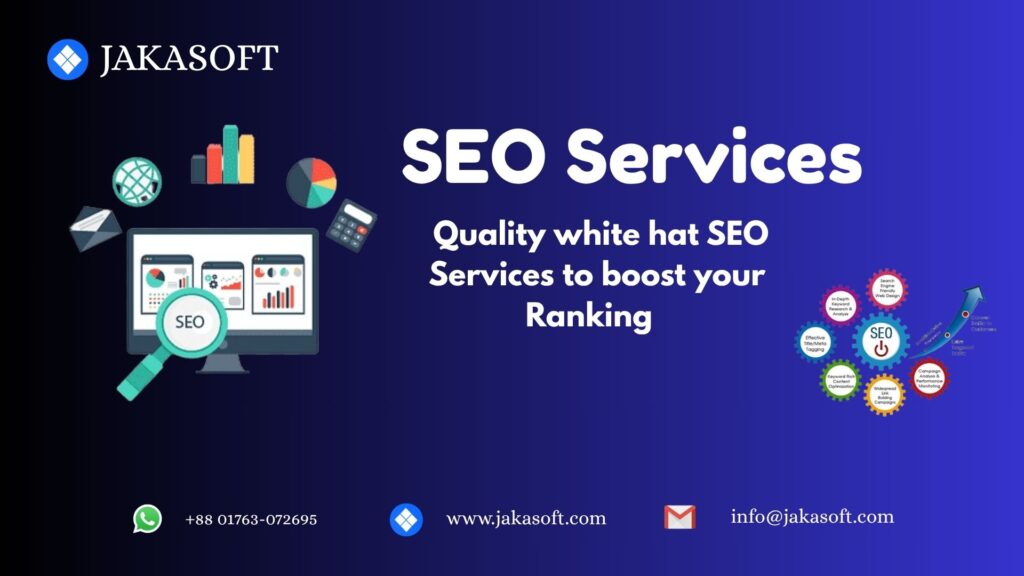
SEO Services SEO Services – Get Found. Get Traffic. Get Results. In today’s digital world, ranking on search engines isn’t optional—it’s essential. At JakaSoft, our SEO Services are designed to help your business appear where it matters most: on the first page of Google. We use proven strategies to increase visibility, attract high-quality traffic, and drive conversions. What is SEO (Search Engine Optimization)? SEO is the process of optimizing your website to rank higher on search engines like Google and Bing. It involves: Technical optimization Keyword research Content strategy Link building User experience improvement ✅ Why Your Business Needs SEO Higher Google Rankings = More visibility Increased Website Traffic = More opportunities More Conversions & Sales = Real ROI Brand Credibility = Become a trusted authority Long-Term Results = Sustainable organic growth Our SEO Services Include 1. SEO Audit & Strategy Complete website analysis Competitor research Actionable roadmap for growth 2. On-Page SEO Keyword optimization Meta tags, titles, and headers Internal linking & content structure 3. Technical SEO Site speed optimization Mobile usability XML sitemaps & schema markup 4. Local SEO Google Business Profile setup Local keywords & citations Maps ranking optimization 5. Off-Page SEO & Link Building High-quality backlinks Outreach & guest blogging Authority building 6. Monthly Reports & Analytics Keyword tracking Traffic & ranking reports Transparent performance updates Who Is This For? Local Businesses E-commerce Brands Bloggers & Influencers Startups & Tech Companies Service-Based Businesses Why Choose JakaSoft for SEO? ✅ White-Hat, Google-Compliant Methods ✅ Customized Strategy for Your Niche ✅ Transparent Monthly Reporting ✅ Proven Results Across Industries ✅ Long-Term SEO Partnership Let’s Boost Your Online Visibility Get in front of the right audience with SEO that actually works.Partner with JakaSoft to take your rankings—and business—to the next level. Visit: www.jakasoft.comWhatsApp: +88 01763-072695Email: info@jakasoft.com #SEOServices #SearchEngineOptimization #GoogleRanking #SEOExperts #JakaSoft #DigitalMarketing #LocalSEO #WebTraffic #SEOBangladesh
Data Integration Services

Data Integration Services Data Integration Services – Connect, Streamline & Optimize Your Data! Struggling with scattered data across multiple platforms? Our Data Integration Services help businesses connect, manage, and streamline data from different sources, ensuring seamless access and better decision-making. Why Data Integration? ✔ Eliminate Data Silos – Combine data from various systems into one.✔ Improve Efficiency – Automate data flow and reduce manual work.✔ Enhance Decision-Making – Get real-time insights for smarter business moves.✔ Boost Data Accuracy – Minimize errors with a structured integration process.✔ Seamless System Connectivity – Connect CRM, ERP, eCommerce, and cloud apps. Our Data Integration Services Cloud & On-Premise Data Integration – Connect local and cloud-based systems.API & Custom Integrations – Seamlessly link third-party apps & databases.ETL (Extract, Transform, Load) Solutions – Automate data extraction & processing.Database Migration & Synchronization – Move & sync data securely.Business Intelligence & Analytics – Turn raw data into actionable insights.Custom Dashboard & Reporting – Access real-time performance metrics. Why Choose JakaSoft? At JakaSoft, we offer customized data integration solutions tailored to your business needs. Whether you’re dealing with ERP, CRM, eCommerce, or cloud platforms, we help you achieve a unified, efficient, and data-driven workflow. Let’s Streamline Your Data for Business Growth! Visit: www.jakasoft.comWhatsApp: +880 1763-072695Email: info@jakasoft.com #DataIntegration #BusinessAutomation #APIs #DataManagement #TechSolutions
Data Entry Service
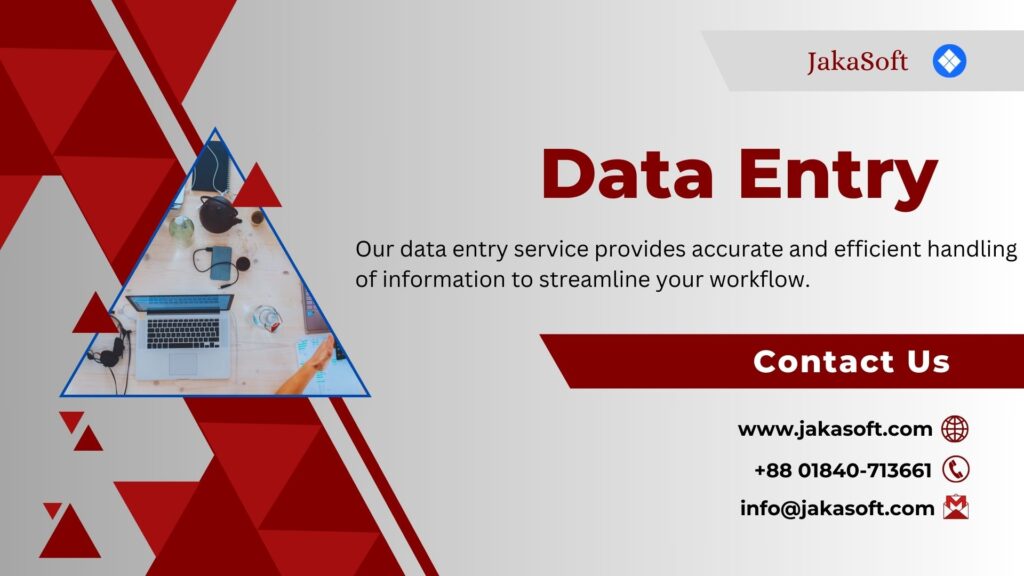
Data Entry Service Data Entry Services – Accurate, Efficient & Scalable Solutions for Your Business! Managing large volumes of data can be time-consuming and prone to errors. At JakaSoft, we offer fast, reliable, and cost-effective Data Entry Services to help businesses streamline operations, reduce workload, and maintain accurate records. Whether you’re a small business, enterprise, or eCommerce store, we provide customized solutions to meet your data processing needs. Why Data Entry Services Matter? ✔ Improved Accuracy – Eliminate human errors with professional data handling.✔ Increased Efficiency – Save time and resources with automated processes.✔ Data Security & Confidentiality – Your sensitive data is protected with strict security measures.✔ Scalability – Handle large volumes of data with ease.✔ Cost-Effective Solutions – Reduce operational costs while maintaining quality. Our Comprehensive Data Entry Services 1. General Data Entry Data input from handwritten, printed, or digital sourcesOnline & offline data entry servicesData sorting, indexing, and validationUpdating and managing business databases 2. Data Conversion & Processing PDF, image, and scanned document conversionData extraction from multiple file formatsOCR (Optical Character Recognition) for automated data entryFile formatting and standardization 3. eCommerce Data Entry Product listing and catalog managementPrice, description, and image updatesInventory and stock managementOrder processing and transaction entry 4. CRM & Database Management Customer data entry & managementSales and leads tracking updatesData mining and data cleansing servicesCloud-based database entry and integration 5. Research & Data Collection Web scraping for business intelligenceMarket research data entrySurvey and form data processingCompetitor analysis and reporting 6. Customized Data Entry Solutions Industry-specific data entry (healthcare, real estate, finance, etc.)Bulk data processing for large enterprisesMultilingual data entry servicesAI-powered and automation-based data entry Why Choose JakaSoft? At JakaSoft, we combine technology, expertise, and industry best practices to provide accurate, secure, and scalable data entry services. Our team ensures quick turnaround times, 100% accuracy, and full data protection so you can focus on your core business operations. Let’s Optimize Your Data Management Today! Visit: www.jakasoft.comWhatsApp: +880 1763-072695Email: info@jakasoft.com #DataEntry #DataManagement #BusinessSolutions #DigitalTransformation #JakaSoft
Database Maintenance and Optimization

Database Maintenance and Optimization In the digital age, databases are the backbone of most applications, handling critical data and supporting business operations. Ensuring that your database is well-maintained and optimized is essential for performance, reliability, and security. Our Database Maintenance and Optimization service is designed to keep your database running smoothly, enhancing its efficiency and supporting your business goals. Why Database Maintenance and Optimization Matter Investing in regular database maintenance and optimization is crucial for several reasons: 1. Improved Performance A well-maintained database runs more efficiently, resulting in faster query responses and improved application performance. Regular optimization helps eliminate bottlenecks and ensures smooth operations. 2. Data Integrity and Reliability Routine maintenance checks help identify and resolve issues that could compromise data integrity. Regular backups and integrity checks ensure that your data remains reliable and recoverable. 3. Enhanced Security Database vulnerabilities can expose sensitive data to threats. Regular maintenance includes security updates and patches, helping protect your database from unauthorized access and data breaches. 4. Cost Efficiency An optimized database consumes fewer resources, leading to reduced operational costs. Proactive maintenance prevents larger issues that could require significant time and financial investment to resolve. Our Database Maintenance and Optimization Process At JakaRiaa, we follow a systematic approach to database maintenance and optimization: Step 1: Initial Assessment We start with a comprehensive assessment of your existing database setup. This includes evaluating performance metrics, identifying potential issues, and understanding your specific requirements. Step 2: Routine Maintenance Tasks We implement regular maintenance tasks, which include: Backup Management: Ensuring that regular backups are performed and verified to safeguard against data loss. Data Integrity Checks: Conducting checks to verify the integrity of your data and identify any corruption issues. Index Maintenance: Regularly reviewing and optimizing indexes to enhance query performance and reduce search times. Step 3: Performance Tuning Our team analyzes query performance and workload patterns to identify optimization opportunities. This includes: Query Optimization: Rewriting slow-performing queries to improve execution times and resource utilization. Database Configuration: Adjusting database settings and configurations to optimize performance based on workload requirements. Partitioning Strategies: Implementing data partitioning techniques to enhance query performance and manage large datasets effectively. Step 4: Security Enhancements We prioritize database security by implementing the latest security measures, including: User Access Control: Reviewing and adjusting user permissions to ensure that only authorized personnel have access to sensitive data. Vulnerability Patching: Regularly applying security patches and updates to protect against known vulnerabilities. Audit Logging: Setting up audit logs to track database access and changes for compliance and security monitoring. Step 5: Monitoring and Reporting After implementing maintenance and optimization strategies, we set up monitoring tools to track database performance continuously. We provide regular reports that highlight performance metrics, potential issues, and recommendations for further improvement. Step 6: Continuous Improvement Database environments are dynamic. We provide ongoing support and recommendations to adapt to changing requirements, ensuring your database remains efficient and effective as your business evolves. Key Areas of Focus Here are specific aspects we emphasize during database maintenance and optimization: Scalability: Preparing your database for future growth by optimizing it for increased workloads and data volume. Disaster Recovery Planning: Developing and implementing strategies to ensure data recovery in the event of a failure or breach. Compliance Management: Ensuring that your database practices comply with relevant regulations and standards, protecting sensitive data. Why Choose us? When it comes to database maintenance and optimization, we stand out for several reasons: Expertise: Our team consists of experienced database administrators and optimization specialists knowledgeable in various database management systems. Tailored Solutions: We recognize that every organization has unique needs. Our approach is customized to fit your specific database environment and business goals. Commitment to Quality: We prioritize thoroughness and reliability in all maintenance and optimization efforts, ensuring high performance and data integrity. Collaborative Engagement: We work closely with you to understand your challenges and goals, ensuring that our solutions align with your organizational objectives. Get Started Today! Are you ready to optimize your database for better performance and reliability? Contact us today for a consultation! Let’s discuss your needs and explore how our database maintenance and optimization services can enhance your operations. Don’t let database issues hinder your success—partner with us for expert management and support! To contact us: Website: www.jakasoft.com WhatsApp:+880 1763-072695 Email: info@jakasoft.com
API Development and Integration
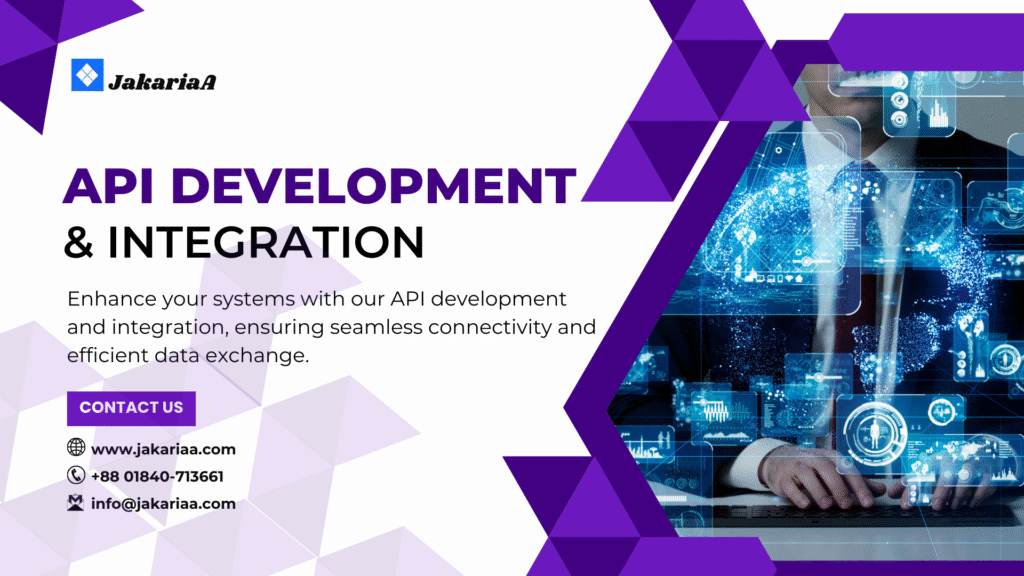
API Development and Integration Streamline Your Operations with Our Expert API Development and Integration Services In today’s interconnected world, APIs (Application Programming Interfaces) are essential for enabling seamless communication between different software applications and services. At JAKARIAA, we specialize in developing and integrating robust APIs that enhance functionality, streamline processes, and drive efficiency. Discover how our API development and integration services can transform your business operations and technology ecosystem. Why API Development and Integration Matter APIs are critical for modern software solutions, offering numerous benefits that can significantly impact your business. Here’s why investing in professional API development and integration is crucial: Enhanced Interoperability APIs enable different systems and applications to communicate and work together seamlessly. This integration allows for more efficient data exchange and interoperability between various software solutions. Increased Efficiency By automating data flows and connecting disparate systems, APIs reduce the need for manual data entry and improve operational efficiency. This leads to faster processes and reduced risk of errors. Scalability and Flexibility APIs provide the flexibility to scale and adapt your technology stack as your business grows. Whether you’re adding new features or integrating with third-party services, APIs offer a scalable solution. Improved User Experience Integrating APIs can enhance the functionality of your applications, offering users a more seamless and enriched experience. This can lead to increased user satisfaction and engagement. Our API Development and Integration Process Requirements Gathering and Planning We start by understanding your specific needs and objectives for the API. Our team works closely with you to define the scope, functionality, and technical requirements of the API. API Design and Architecture Our experts design a scalable and secure API architecture that meets your requirements. We focus on creating a well-structured API that is easy to maintain and integrate with other systems. Development and Testing We develop your API using the latest technologies and best practices to ensure high performance and reliability. Rigorous testing is conducted to ensure the API functions correctly and integrates seamlessly with your existing systems. Integration and Implementation We handle the integration of the API into your existing applications or systems. Our team ensures a smooth implementation process, addressing any compatibility issues and ensuring that the integration is successful. Documentation and Support Comprehensive documentation is provided to facilitate the use and maintenance of the API. We also offer ongoing support to address any issues, updates, or enhancements needed post-implementation. Why Choose Us? Experienced Developers: Our team has extensive experience in building and integrating APIs across various industries and technology stacks. Tailored Solutions: We create custom API solutions that align with your specific business needs and technical requirements. Collaborative Approach: We work closely with you throughout the development and integration process to ensure that the final solution meets your expectations and goals. End-to-End Service: From initial design to ongoing support, we provide a comprehensive range of API development and integration services. Get Started with Our API Development and Integration Services Ready to enhance your technology ecosystem with powerful APIs? Contact us today to schedule a consultation and discover how our API development and integration services can help you achieve greater efficiency and flexibility in your operations. To contact us: Website: www.jakasoft.com WhatsApp:+880 1763-072695 Email: info@jakasoft.com
Data Conversion
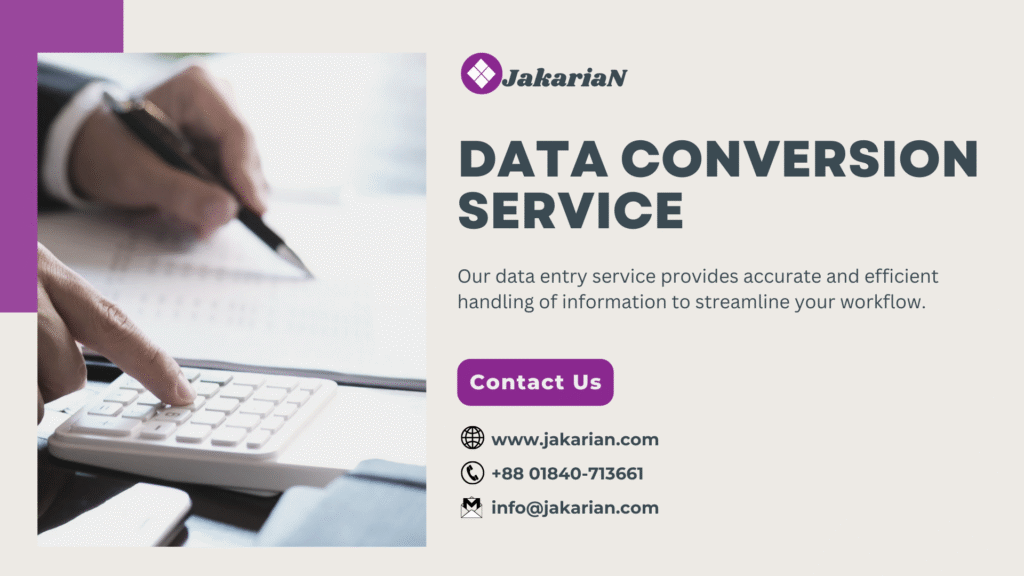
Data Conversion Data Conversion is a service focused on transforming data from one format or structure to another to ensure compatibility, usability, and accuracy. This service is crucial for organizations and individuals needing to migrate data between systems, formats, or platforms, and for ensuring that data is accessible and functional across different applications. Key components of Data Conversion include: 1. Format Transformation: Converting data from one file format to another, such as CSV to Excel, XML to JSON, or PDF to Word. This ensures that data can be used in different software applications and systems. 2. Data Migration: Transferring data between different databases, systems, or platforms. This includes ensuring that data is accurately moved and remains intact during the migration process. 3. Data Cleaning and Preparation: Preparing data for conversion by cleaning and validating it. This involves correcting errors, removing duplicates, and ensuring that the data is in a consistent format before conversion. 4. Schema Mapping: Mapping data from one schema to another to ensure that data fields align correctly in the target format. This includes defining how data elements in the source format correspond to those in the target format. 5. Data Integration: Combining data from multiple sources into a unified format. This includes integrating disparate datasets to create a cohesive and comprehensive dataset. 6. Validation and Quality Assurance: Ensuring the accuracy and integrity of the converted data. This includes validating that data has been correctly converted and meets the required quality standards. 7. Automated Conversion Tools: Utilizing specialized tools and software for automated data conversion. This includes using scripts, applications, and platforms designed to efficiently handle large volumes of data conversion. 8. Manual Data Conversion: Performing manual data conversion for cases where automation is not feasible. This includes manually transferring data between formats while ensuring accuracy and consistency. 9. Documentation and Reporting: Providing documentation and reports on the data conversion process. This includes detailing the steps taken, the formats involved, and any issues encountered during conversion. 10. Conversion for Analysis: Converting data into formats suitable for analysis and reporting. This includes preparing data for use in analytical tools, dashboards, and business intelligence applications. 11. Data Enrichment: Enhancing data during the conversion process by adding additional information or context. This includes appending data from external sources to improve its value and usability. 12. Support and Troubleshooting: Offering support and troubleshooting for issues that arise during the data conversion process. This includes addressing any problems with data compatibility, errors, or discrepancies. 13. Custom Conversion Solutions: Developing customized data conversion solutions tailored to specific needs and requirements. This includes creating bespoke conversion processes for unique data formats or structures. 14. Security and Compliance: Ensuring that data is handled securely and in compliance with relevant regulations and standards. This includes protecting sensitive information and adhering to data privacy laws during the conversion process. 15. Post-Conversion Support: Providing support after the data conversion is complete to address any issues or adjustments needed. This includes verifying that the converted data functions correctly in its new format and assisting with any follow-up tasks. Data Conversion is essential for ensuring that data is accessible, compatible, and usable across different systems and formats. This service ensures a smooth transition between data formats, maintains data integrity, and supports effective data management and utilization. Compare Our Packages No Package Basic Standard Premium 01 Description 02 Title optimization 03 04 05 06 05 06 07 08 09 10 11 12 13 14 15 16 17 18 19 20 To contact us: Website: info@jakasoft.com WhatsApp:+880 1763-072695 Email: info@jakasoft.com
Data Cleansing and Validation
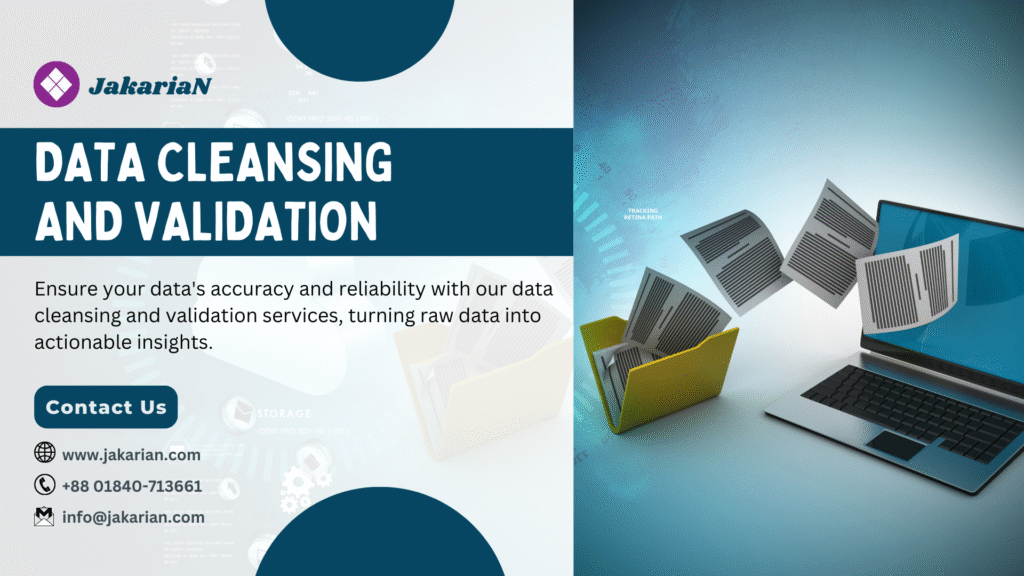
Data Cleansing and Validation Data Cleansing and Validation is the process of improving the quality, accuracy, and reliability of data by identifying and correcting errors, inconsistencies, and inaccuracies within a dataset. This service is essential for businesses, researchers, and organizations that rely on high-quality data to make informed decisions, conduct analysis, and maintain efficient operations. Key aspects of Data Cleansing and Validation include: 1. Data Quality Assessment: Initial Review: Conducting an initial assessment of the dataset to identify common data quality issues such as missing values, duplicate entries, and outliers. Data Profiling: Analyzing the data to understand its structure, content, and relationships, helping to identify patterns and anomalies that require attention. 2. Error Identification and Correction: Missing Data Handling: Detecting and addressing missing or incomplete data, either by imputing values, using statistical methods, or excluding incomplete records based on the context. Duplicate Removal: Identifying and removing duplicate records to ensure the uniqueness and accuracy of the dataset. Inconsistency Resolution: Correcting inconsistencies in data formats, such as date formats, currency symbols, or unit measurements, to maintain uniformity across the dataset. 3. Data Standardization: Format Consistency: Standardizing data formats, such as converting text to proper case, aligning date formats, or ensuring consistent use of abbreviations and acronyms. Normalization: Normalizing data to a standard scale or format, making it easier to compare and analyze across different datasets or systems. 4. Data Validation Techniques: Range and Constraint Checks: Ensuring data values fall within acceptable ranges or meet specific criteria (e.g., age between 18-65, prices above zero). Cross-Referencing: Validating data by cross-referencing it with external sources, databases, or reference tables to ensure its accuracy and relevance. Logic Checks: Implementing logical checks to validate relationships between data points, such as ensuring that start dates precede end dates or that quantities match corresponding totals. 5. Outlier Detection and Handling: Outlier Identification: Detecting outliers or anomalous data points that deviate significantly from the expected pattern, which could indicate errors or require further investigation. Outlier Management: Deciding on an appropriate approach to manage outliers, such as correction, removal, or analysis, depending on their impact on the dataset. 6. Data Enrichment: Enhancing Data: Adding or enriching data with additional information, such as geolocation data, demographic details, or industry classifications, to increase its value and usability. Data Augmentation: Integrating supplementary data from reliable external sources to fill gaps, enhance accuracy, or provide additional context. 7. Data Integrity Preservation: Audit Trails: Maintaining detailed audit trails of all data cleansing and validation activities, ensuring transparency and traceability. Backup and Recovery: Creating backups of original datasets before performing cleansing and validation to preserve the integrity of the data and allow for rollback if necessary. 8. Reporting and Documentation: Cleansing Reports: Generating reports that document the data cleansing and validation process, including the types of errors found, the actions taken, and the overall improvement in data quality. Validation Logs: Keeping logs of validation checks and their outcomes, providing a comprehensive record of data quality assurance activities. 9. Continuous Monitoring and Maintenance: Ongoing Quality Checks: Implementing continuous monitoring systems to regularly check data quality, ensuring that the data remains accurate and up-to-date over time. Automated Processes: Utilizing automated tools and scripts to perform routine data cleansing and validation, reducing manual effort and ensuring consistency. Data Cleansing and Validation are critical for maintaining the accuracy and reliability of data, enabling organizations to trust their data-driven insights and decisions. By ensuring data is clean, consistent, and validated, this service helps eliminate errors, reduce risks, and enhance the overall effectiveness of data management and analysis efforts. Compare Our Packages No Package Basic Standard Premium 01 Description 02 Title optimization 03 04 05 06 05 06 07 08 09 10 11 12 13 14 15 16 17 18 19 20 To contact us: Website: info@jakasoft.com WhatsApp:+880 1763-072695 Email: info@jakasoft.com
Data Collection

Data Collection Data Collection is the systematic process of gathering, measuring, and recording information from various sources to provide a foundation for analysis, decision-making, and research. This service is crucial for businesses, researchers, and organizations that need accurate and comprehensive data to support strategic initiatives, monitor performance, or gain insights into specific areas. Key aspects of Data Collection include: 1. Objective Definition: Goal Setting: Clearly defining the objectives and purpose of data collection, whether it’s for market research, performance tracking, customer insights, or scientific studies. Target Data Identification: Identifying the specific types of data needed, such as quantitative data (e.g., sales figures, customer demographics) or qualitative data (e.g., customer feedback, survey responses). 2. Data Sources and Methods: Primary Data Collection: Gathering original data directly from sources through methods such as surveys, interviews, focus groups, observations, and experiments. Secondary Data Collection: Collecting data from existing sources such as reports, databases, academic journals, websites, and government publications. Data Gathering Techniques: Utilizing various techniques like online forms, questionnaires, web scraping, API integrations, and manual data entry to collect the necessary information. 3. Sampling and Targeting: Sampling Strategy: Determining the sample size and method (e.g., random sampling, stratified sampling) to ensure the data collected is representative of the larger population. Target Audience Identification: Identifying and targeting the appropriate audience or entities from which to collect data, ensuring relevance and accuracy. 4. Data Validation and Accuracy: Data Verification: Checking the accuracy and completeness of the collected data, ensuring it aligns with the set objectives and criteria. Error Detection: Identifying and correcting any inconsistencies, duplicates, or errors in the data to maintain its integrity. 5. Data Organization and Management: Data Storage: Organizing collected data in structured formats such as databases, spreadsheets, or cloud storage, making it easily accessible for analysis and reporting. Data Categorization: Categorizing and labeling data based on relevant parameters, such as date, source, or category, to facilitate efficient data retrieval and analysis. 6. Data Privacy and Security: Confidentiality: Ensuring that sensitive data is collected and stored in compliance with privacy laws and regulations, protecting personal and proprietary information. Access Control: Implementing secure access controls to ensure that only authorized personnel can view or manipulate the collected data. 7. Reporting and Documentation: Data Summarization: Compiling and summarizing the collected data into reports, charts, or dashboards that highlight key findings and trends. Documentation: Keeping detailed records of the data collection process, including methodologies, tools used, and any issues encountered, ensuring transparency and traceability. 8. Continuous Monitoring and Updating: Ongoing Data Collection: Setting up systems for continuous or periodic data collection to keep information up-to-date and relevant. Data Refresh: Regularly updating the data to reflect the latest information and maintaining the accuracy of datasets over time. Data Collection is fundamental for understanding trends, behaviors, and outcomes that drive decision-making and strategic planning. Whether for business intelligence, academic research, or operational improvements, efficient and effective data collection provides the insights necessary to achieve goals and succeed in a data-driven world. Compare Our Packages No Package Basic Standard Premium 01 Description 02 Title optimization 03 04 05 06 05 06 07 08 09 10 11 12 13 14 15 16 17 18 19 20 To contact us: Website: info@jakasoft.com WhatsApp:+880 1763-072695 Email: info@jakasoft.com
Web Research
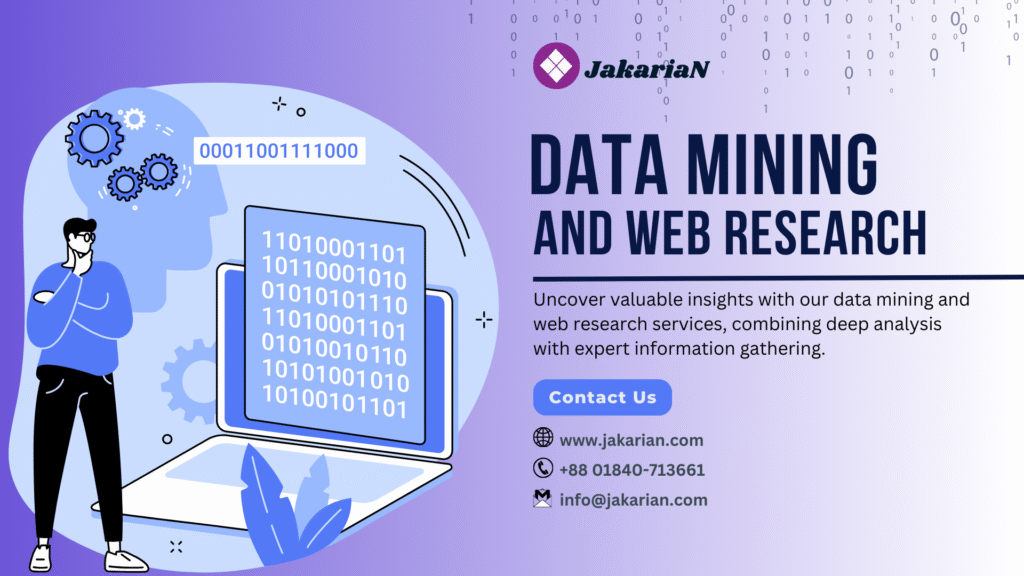
Web Research Web Research is a specialized service focused on gathering, analyzing, and synthesizing information from various online sources to support business decisions, market analysis, content creation, and other strategic initiatives. This service is ideal for businesses, researchers, and individuals seeking accurate and up-to-date information on specific topics. Key components of Web Research include: 1. Information Gathering: Targeted Research: Conducting thorough research on specific topics, industries, markets, competitors, or trends using reputable online sources such as academic journals, industry reports, websites, news articles, and social media. Data Collection: Collecting relevant data, statistics, case studies, and examples that align with the research objectives, ensuring the information is comprehensive and relevant. 2. Source Verification and Credibility: Source Evaluation: Assessing the credibility, reliability, and authority of online sources to ensure that the information gathered is accurate, unbiased, and trustworthy. Cross-Referencing: Verifying information by cross-referencing multiple sources, reducing the risk of misinformation or inaccuracies. 3. Data Analysis and Synthesis: Data Interpretation: Analyzing collected data to identify patterns, trends, insights, and key findings that are valuable to the research goals. Synthesis of Information: Summarizing and organizing information into coherent, easily digestible formats such as reports, summaries, or presentations that highlight the most critical insights. 4. Market and Competitive Analysis: Market Research: Exploring market trends, customer behaviors, and industry developments to inform business strategies, product development, or marketing campaigns. Competitor Analysis: Identifying and evaluating competitors’ online presence, strategies, and offerings to understand their strengths, weaknesses, and market positioning. 5. Content Research and Development: Content Sourcing: Gathering information to support content creation, including blogs, articles, white papers, and social media posts, ensuring content is factual, relevant, and engaging. Trend Identification: Identifying emerging topics, keywords, and industry trends that can inspire content ideas or inform editorial calendars. 6. Lead Generation and Contact Research: Prospect Identification: Researching potential leads, clients, or partners by identifying contact information, company details, and decision-makers through various online platforms. Contact Verification: Verifying and updating contact details to ensure they are current and accurate for outreach and communication efforts. 7. Reporting and Documentation: Research Reports: Compiling detailed research reports that present findings, insights, and recommendations, tailored to the specific needs of the client or project. Data Documentation: Organizing and documenting the research process and sources used, providing transparency and traceability for future reference. 8. Continuous Updates and Monitoring: Ongoing Research: Monitoring online sources regularly to stay updated on new developments, changes, or trends in a specific field, providing timely insights. Alert Systems: Setting up alerts or notifications for specific keywords, topics, or competitors to receive real-time updates and act on new information promptly. Web Research is essential for businesses, academics, and professionals who need accurate and detailed information to make informed decisions, develop strategies, and create high-quality content. By leveraging the vast amount of data available online, web research enables organizations to stay ahead of trends, understand their markets better, and gain a competitive edge. Compare Our Packages No Package Basic Standard Premium 01 Description 02 Title optimization 03 04 05 06 05 06 07 08 09 10 11 12 13 14 15 16 17 18 19 20 To contact us- Website: info@jakasoft.com WhatsApp:+880 1763-072695 Email: info@jakasoft.com
Data Entry

Data Entry Data Entry involves the accurate and efficient inputting, updating, and managing of various types of data into digital systems or databases. This service is essential for businesses and organizations that require meticulous record-keeping and data organization. Key aspects of Data Entry include: 1. Data Collection and Input: Manual Data Entry: Inputting data from physical documents, forms, or spreadsheets into digital formats, ensuring accuracy and consistency. Digital Data Entry: Transferring data from one digital format to another, such as from scanned documents, emails, or online forms into databases or software systems. 2. Data Verification and Validation: Accuracy Checks: Reviewing entered data to ensure it matches the original source material, correcting any errors or discrepancies. Data Validation: Ensuring the data entered adheres to predefined formats, rules, and standards to maintain data integrity and quality. 3. Database Management: Database Updating: Regularly updating and maintaining databases with new entries, edits, or deletions as needed. Data Organization: Organizing data into categories, tables, or fields that make it easy to retrieve and analyze. 4. Handling Confidential Information: Data Security: Managing sensitive and confidential information with strict adherence to data protection and privacy regulations. Access Control: Ensuring that only authorized personnel have access to specific data, protecting it from unauthorized access or breaches. 5. Speed and Efficiency: Timely Completion: Performing data entry tasks quickly without compromising accuracy, meeting deadlines for data entry projects. Batch Processing: Handling large volumes of data efficiently by processing it in batches, optimizing workflow and productivity. 6. Software Proficiency: Use of Data Entry Tools: Proficiency in using various data entry software, spreadsheets, databases, and content management systems (CMS) to input and manage data. Automation Tools: Utilizing automation tools for repetitive data entry tasks, reducing manual effort and minimizing errors. 7. Reporting and Documentation: Generating Reports: Producing detailed reports based on entered data, providing insights, summaries, or statistics as required. Record Keeping: Maintaining comprehensive records of data entry activities, ensuring transparency and accountability. Data Entry is crucial for maintaining organized, accessible, and accurate records, supporting decision-making processes, and ensuring smooth business operations. Whether it involves entering customer information, financial data, product details, or any other type of information, effective data entry contributes to the overall efficiency and success of an organization Compare Our Packages No Package Basic Standard Premium 01 Description 02 Title optimization 03 04 05 06 05 06 07 08 09 10 11 12 13 14 15 16 17 18 19 20 To contact us- Website: info@jakasoft.com WhatsApp:+880 1763-072695 Email: info@jakasoft.com
Advanced Keyword Ranking Techniques

Advanced Keyword Ranking Techniques Unlock the full potential of your website with our “Advanced Keyword Ranking Techniques” service. At our Company, we leverage cutting-edge strategies to ensure your website not only ranks but dominates in search engine results. Our approach goes beyond basic keyword research, employing advanced methodologies and tools to identify high-impact keywords that drive targeted traffic and boost conversions. With years of experience in SEO, our team excels in implementing sophisticated ranking techniques tailored to your unique business needs. Whether you’re looking to enhance your current keyword strategy or overhaul your approach entirely, our expertise will propel your website to new heights in search engine rankings. My Service Includes: Advanced Profitable Keyword Research Competitor Analysis Website Audit Action Plan for Organic Growth 100% Satisfaction Guarantee For Each Keyword, You Will Receive: Average Monthly Search Volume Keyword Difficulty Cost Per Click (CPC) Estimated Monthly Traffic Why Me? Proven Expertise: With over 5 years in the industry, we have a deep understanding of what works in SEO. Advanced Techniques: we use cutting-edge tools and methods, ensuring you get the most profitable keywords. Comprehensive Approach: My services don’t stop at keyword research; we provide actionable insights and strategies for growth. Client Satisfaction: We are committed to delivering results that exceed expectations, with a guarantee of your satisfaction. Note: Purchase our PREMIUM keyword research package, and we will also optimize your website speed, ensuring faster rankings and better organic performance. Compare Our Packages No Package Basic Standard Premium 01 Description Keyword Research in Excel doc + 1 Competitor Keywords+ Bonus Keyword Research in Excel doc + 2 Competitor Keywords+ Bonus Keyword Research in Excel doc + 5 Competitor Keywords+ bonus 02 Website audit √ √ √ 03 Action plan √ √ √ 04 Keywords researched 20 35 50 05 Competitors researched 1 2 5 06 Delivery Time 3 days 5 days 7 days 05 Total $30 $60 $100 06 07 08 09 10 11 12 13 14 15 16 17 18 19 20 To contact us- Website: info@jakasoft.com WhatsApp:+880 1763-072695 Email: info@jakasoft.com
Specialized Data Entry

Specialized Data Entry Specialized Data Entry is a tailored service focused on accurately and efficiently inputting and managing data in specific, often complex, fields or industries. This service is designed to handle data that requires specialized knowledge, detailed understanding, or adherence to particular standards. It supports various sectors, including healthcare, finance, legal, and more, by ensuring that data is processed correctly and aligns with industry-specific requirements. Key components of Specialized Data Entry include: 1. Industry-Specific Data Handling: Healthcare Data Entry: Inputting medical records, patient information, and clinical data while adhering to healthcare regulations such as HIPAA. This includes managing electronic health records (EHRs), treatment histories, and diagnostic codes. Financial Data Entry: Handling financial documents, transaction records, and investment data with precision. This involves entering financial statements, account details, and transaction histories while ensuring compliance with financial regulations. Legal Data Entry: Managing legal documents, case files, and client records in accordance with legal standards and confidentiality requirements. This includes inputting case notes, legal briefs, and court records. E-commerce Data Entry: Updating and managing product listings, inventory data, and customer orders for online retail platforms. This includes handling product descriptions, pricing, and stock levels. 2. Data Accuracy and Quality Control: Precision Input: Ensuring high accuracy in data entry by meticulously entering data into databases, spreadsheets, or other systems. This involves careful attention to detail and adherence to data entry standards. Error Checking: Implementing quality control measures to detect and correct errors or inconsistencies in the data. This includes performing regular audits, validation checks, and data verification. 3. Advanced Data Processing: Complex Data Structures: Handling complex data formats and structures, such as multi-field forms, nested data, and hierarchical records. This may involve inputting data from various sources, including scanned documents, PDFs, and spreadsheets. Data Conversion: Converting data from one format to another, such as from paper to digital, or from one software system to another. This includes data migration and transformation tasks. 4. Confidentiality and Compliance: Data Security: Ensuring the confidentiality and security of sensitive data by following industry-specific regulations and best practices. This involves implementing secure data handling procedures and protecting personal or confidential information. Regulatory Compliance: Adhering to relevant regulatory requirements and standards specific to the industry, such as data protection laws, industry guidelines, and organizational policies. 5. Custom Data Entry Solutions: Tailored Services: Providing customized data entry solutions based on the specific needs of the client or industry. This includes developing specialized data entry workflows, tools, and procedures. Integration with Systems: Integrating data entry processes with existing systems or databases, ensuring seamless data flow and compatibility with other software applications. 6. Reporting and Documentation: Data Reporting: Generating reports and summaries based on the entered data, providing insights and facilitating analysis. This includes creating data reports, summaries, and visualizations as needed. Documentation: Maintaining detailed records of the data entry process, including data sources, methods used, and any issues encountered. This ensures transparency and supports future reference. 7. Continuous Improvement: Process Optimization: Continuously evaluating and improving data entry processes to enhance efficiency and accuracy. This includes implementing new technologies, tools, and techniques to streamline data entry tasks. Training and Development: Providing ongoing training and support for data entry personnel to keep them updated on industry standards, best practices, and new tools or technologies. Specialized Data Entry is essential for managing data in industries that require specific knowledge and adherence to stringent standards. By offering precise, secure, and customized data entry services, this solution ensures that complex and sensitive data is handled effectively, supporting accurate reporting, compliance, and operational efficiency. Compare Our Packages No Package Basic Standard Premium 01 Description 02 Title optimization 03 04 05 06 05 06 07 08 09 10 11 12 13 14 15 16 17 18 19 20 To contact us- Website: info@jakasoft.com WhatsApp:+880 1763-072695 Email: info@jakasoft.com
Data Mining and Web Research

Data Mining and Web Research Data Mining and Web Research is a combined service that focuses on extracting valuable insights from large datasets and gathering information from online sources. This service is designed to help businesses, researchers, and organizations make informed decisions by leveraging both structured data analysis and comprehensive online research. Key components include: 1. Data Mining: Pattern Recognition: Identifying patterns, trends, and correlations within large datasets using techniques such as clustering, classification, and association rule mining. This helps uncover hidden insights and relationships in the data. Predictive Analysis: Using statistical and machine learning models to predict future trends, behaviors, or outcomes based on historical data. This can assist in forecasting sales, customer behavior, or market trends. Data Cleaning and Preparation: Preparing data for analysis by cleaning, transforming, and structuring it to ensure accuracy and relevance. This involves handling missing values, removing duplicates, and standardizing data formats. Advanced Analytics: Applying advanced techniques such as regression analysis, neural networks, and data visualization to extract deeper insights and support complex decision-making processes. Anomaly Detection: Identifying unusual or outlier data points that may indicate fraud, errors, or significant deviations from expected patterns. 2. Web Research: Information Gathering: Collecting data from a variety of online sources including websites, academic journals, news articles, and social media platforms. This involves using search engines, online databases, and other research tools. Source Evaluation: Assessing the credibility and reliability of online sources to ensure that the information gathered is accurate and trustworthy. This includes cross-referencing multiple sources and verifying facts. Competitive Analysis: Researching competitors’ online presence, strategies, and market positioning to gain insights into their strengths, weaknesses, and industry trends. Market and Industry Research: Gathering information on market trends, customer preferences, and industry developments to support strategic planning, product development, and marketing efforts. Data Integration: Combining data obtained from web research with internal data sources to provide a comprehensive view and enhance the overall analysis. 3. Data Integration and Synthesis: Combining Insights: Integrating findings from data mining and web research to create a unified view of the data. This involves synthesizing quantitative data from mining with qualitative insights from web research. Reporting: Generating detailed reports, dashboards, and visualizations that present the combined insights in a clear and actionable format. This helps stakeholders make data-driven decisions and understand key findings. 4. Trend Analysis and Forecasting: Trend Identification: Analyzing both historical data and current web research to identify emerging trends and patterns that could impact business or research objectives. Forecasting: Using data mining techniques and online research insights to project future developments, such as market growth, consumer behavior, or technological advancements. 5. Compliance and Ethical Considerations: Data Privacy: Ensuring that all data mining and web research activities comply with data protection regulations and respect user privacy. This includes handling sensitive information responsibly and following ethical guidelines. Transparency: Providing transparent documentation of data sources, methodologies, and findings to maintain credibility and support the validity of the research. 6. Continuous Monitoring and Updates: Ongoing Analysis: Setting up systems for continuous data mining and web research to keep information up-to-date and relevant. This involves regular updates and monitoring of trends and data changes. Alert Systems: Implementing alerts or notifications for significant changes or new information that could impact the research objectives or business strategies. Data Mining and Web Research provides a comprehensive approach to extracting actionable insights from both structured datasets and unstructured online information. By combining advanced analytical techniques with thorough online research, this service enables organizations to uncover valuable insights, make informed decisions, and stay ahead of market trends. Compare Our Packages No Package Basic Standard Premium 01 Description 02 Title optimization 03 04 05 06 05 06 07 08 09 10 11 12 13 14 15 16 17 18 19 20 To contact us- Website: info@jakasoft.com WhatsApp:+880 1763-072695 Email: info@jakasoft.com
Database Management
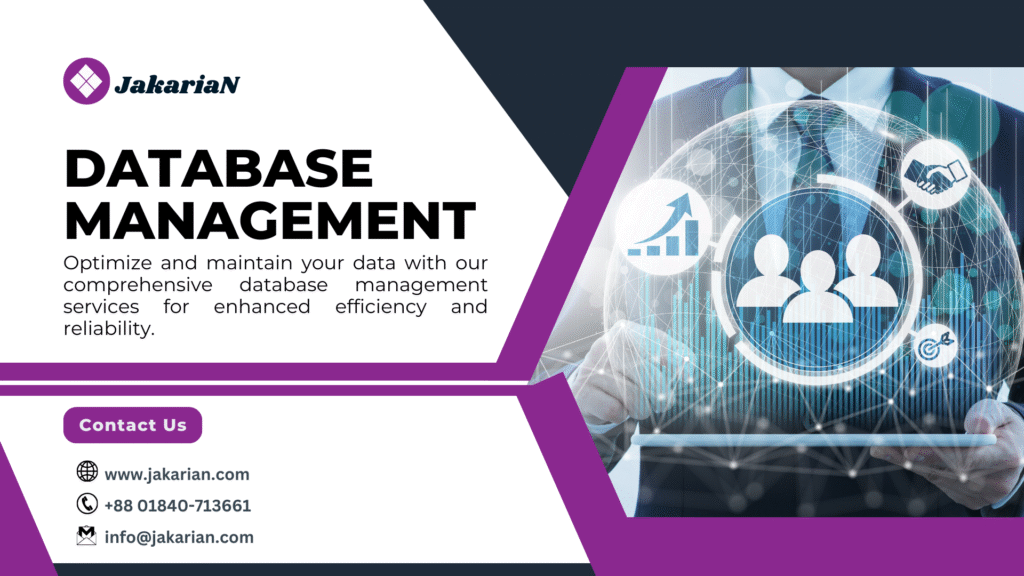
Database Management Database Management involves the systematic organization, maintenance, and administration of databases to ensure data is stored efficiently, remains accessible, and supports the needs of users and applications. This service is crucial for businesses and organizations that rely on databases to handle and analyze large volumes of information, facilitate transactions, and support decision-making processes. Key aspects of Database Management include: 1. Database Design and Architecture: Schema Design: Designing the structure of the database, including tables, fields, relationships, and constraints, to ensure it supports the organization’s data requirements and business processes. Normalization: Applying normalization techniques to reduce data redundancy and improve data integrity, organizing data into related tables to minimize duplication. 2. Database Implementation: Database Creation: Setting up and configuring databases based on the designed schema, including creating tables, indexes, views, and other database objects. Data Migration: Migrating data from existing systems or sources into the new database, ensuring a smooth transition and preserving data accuracy and consistency. 3. Data Storage and Retrieval: Data Insertion and Update: Managing the insertion, updating, and deletion of data within the database, ensuring data integrity and accuracy through proper transaction handling. Query Optimization: Developing and optimizing queries to retrieve data efficiently, improving performance and reducing response times for data access. 4. Database Security: Access Control: Implementing security measures to control user access, including setting up user roles, permissions, and authentication methods to protect sensitive data. Data Encryption: Using encryption techniques to secure data both at rest and in transit, safeguarding it from unauthorized access and breaches. 5. Backup and Recovery: Backup Strategies: Implementing regular backup procedures to ensure that data is preserved and can be restored in case of loss, corruption, or system failure. Disaster Recovery: Developing and maintaining disaster recovery plans to ensure data can be quickly and effectively recovered following significant incidents or outages. 6. Performance Monitoring and Tuning: Database Performance: Monitoring database performance metrics such as query response times, transaction rates, and resource utilization to identify and address performance issues. Optimization: Tuning database settings, indexes, and queries to enhance performance, ensuring efficient operation and optimal resource usage. 7. Data Integrity and Validation: Data Validation: Implementing constraints and validation rules to ensure that data entered into the database adheres to defined formats, ranges, and relationships. Integrity Checks: Performing regular checks to ensure data integrity, identifying and resolving issues related to data accuracy, consistency, and reliability. 8. User and Role Management: User Management: Creating and managing user accounts, roles, and permissions, ensuring that users have appropriate access levels based on their needs and responsibilities. Audit Trails: Maintaining audit trails and logs of user activities, changes, and transactions within the database to track usage and ensure accountability. 9. Documentation and Reporting: Database Documentation: Keeping comprehensive documentation of the database design, schema, and configurations, providing a reference for future maintenance and development. Reporting: Generating reports and dashboards that summarize database performance, usage statistics, and other relevant metrics to support decision-making and analysis. 10. Continuous Maintenance and Updates: Regular Maintenance: Performing routine maintenance tasks such as database reorganization, cleanup, and updates to ensure ongoing stability and efficiency. Software Updates: Applying patches and updates to database management systems (DBMS) to fix vulnerabilities, enhance features, and ensure compatibility with other systems. Database Management is essential for ensuring that data is organized, secure, and accessible, enabling organizations to leverage their data effectively for operational and strategic purposes. By managing the lifecycle of databases from design through maintenance, this service supports the integrity, performance, and security of critical data assets. Compare Our Packages No Package Basic Standard Premium 01 Description 02 Title optimization 03 04 05 06 05 06 07 08 09 10 11 12 13 14 15 16 17 18 19 20 To contact us: Website: info@jakasoft.com WhatsApp:+880 1763-072695 Email: info@jakasoft.com
Keyword Research Strategy

Keyword Research and Strategy Keyword Research and Strategy is a foundational service aimed at identifying the most effective keywords to drive relevant traffic to your website, increase visibility in search engine results, and achieve your business objectives. This service is essential for building a strong SEO (Search Engine Optimization) or PPC (Pay-Per-Click) advertising campaign. Key components include: 1. Business and Market Analysis: Understanding Business Goals: Begin by understanding your business goals, target audience, and competitive landscape to align keyword strategy with overall objectives. Industry Trends: Analyze industry trends and search behavior patterns to identify potential opportunities for targeting specific keywords. 2. Comprehensive Keyword Research: Keyword Identification: Conduct in-depth research to identify a broad range of relevant keywords and phrases that potential customers use when searching for products or services similar to yours. Long-Tail Keywords: Identify long-tail keywords that are highly specific, less competitive, and more likely to attract targeted traffic with a higher conversion potential. Competitor Analysis: Analyze competitors’ keyword strategies to identify gaps and opportunities for your business. This includes studying the keywords they rank for and targeting those that can give you a competitive edge. 3. Keyword Grouping and Categorization: Keyword Segmentation: Organize keywords into relevant groups and categories based on themes, search intent, and relevance to different stages of the customer journey. Priority Setting: Prioritize keywords based on factors such as search volume, competition level, and relevance to your business goals. 4. Search Intent Analysis: User Intent Categorization: Categorize keywords by user intent, such as informational, navigational, transactional, or commercial investigation, to better align content and ads with user expectations. Content Alignment: Align keywords with appropriate content types, ensuring that each keyword group is supported by relevant landing pages, blog posts, product pages, or other content formats. 5. Keyword Strategy Development: SEO Strategy: Develop an on-page SEO strategy that includes keyword placement in meta titles, descriptions, headers, and throughout the content to improve organic search rankings. PPC Strategy: Craft a PPC keyword strategy that focuses on high-performing keywords for ad campaigns, including bidding strategies for competitive keywords and budget allocation for different keyword groups. 6. Ongoing Monitoring and Refinement: Performance Tracking: Continuously monitor keyword performance metrics such as rankings, traffic, conversion rates, and cost-per-click (CPC) for PPC campaigns. Keyword Refinement: Regularly refine and update the keyword list based on performance data, emerging trends, and changes in search behavior to ensure the strategy remains effective and relevant. 7. Competitor Gap Analysis: Identifying Opportunities: Identify keywords your competitors are not targeting but have significant search potential, giving you an opportunity to fill that gap and capture untapped traffic. Benchmarking: Benchmark your keyword performance against competitors to understand where you stand in the market and adjust your strategy accordingly. 8. Reporting and Insights: Detailed Reports: Provide detailed reports on keyword research findings, strategy implementation, and performance outcomes, along with actionable insights for ongoing optimization. Strategic Recommendations: Offer strategic recommendations based on data analysis to enhance keyword targeting, improve rankings, and increase ROI. This service is designed to provide a robust keyword strategy that not only enhances your search engine visibility but also drives meaningful traffic that aligns with your business goals. By leveraging data-driven insights and a deep understanding of search intent, Keyword Research and Strategy ensures your marketing efforts are focused on the most impactful keywords, leading to better performance and results. Compare Our Packages No Package Basic Standard Premium 01 Description 02 Title optimization 03 04 05 06 05 06 07 08 09 10 11 12 13 14 15 16 17 18 19 20 To contact us- Website: info@jakasoft.com WhatsApp:+880 1763-072695 Email: info@jakasoft.com
Data Mining and Web Research

Data Mining and Web Research Data Mining and Web Research is a combined service that focuses on extracting valuable insights from large datasets and gathering information from online sources. This service is designed to help businesses, researchers, and organizations make informed decisions by leveraging both structured data analysis and comprehensive online research. Key components include: 1. Data Mining: Pattern Recognition: Identifying patterns, trends, and correlations within large datasets using techniques such as clustering, classification, and association rule mining. This helps uncover hidden insights and relationships in the data. Predictive Analysis: Using statistical and machine learning models to predict future trends, behaviors, or outcomes based on historical data. This can assist in forecasting sales, customer behavior, or market trends. Data Cleaning and Preparation: Preparing data for analysis by cleaning, transforming, and structuring it to ensure accuracy and relevance. This involves handling missing values, removing duplicates, and standardizing data formats. Advanced Analytics: Applying advanced techniques such as regression analysis, neural networks, and data visualization to extract deeper insights and support complex decision-making processes. Anomaly Detection: Identifying unusual or outlier data points that may indicate fraud, errors, or significant deviations from expected patterns. 2. Web Research: Information Gathering: Collecting data from a variety of online sources including websites, academic journals, news articles, and social media platforms. This involves using search engines, online databases, and other research tools. Source Evaluation: Assessing the credibility and reliability of online sources to ensure that the information gathered is accurate and trustworthy. This includes cross-referencing multiple sources and verifying facts. Competitive Analysis: Researching competitors’ online presence, strategies, and market positioning to gain insights into their strengths, weaknesses, and industry trends. Market and Industry Research: Gathering information on market trends, customer preferences, and industry developments to support strategic planning, product development, and marketing efforts. Data Integration: Combining data obtained from web research with internal data sources to provide a comprehensive view and enhance the overall analysis. 3. Data Integration and Synthesis: Combining Insights: Integrating findings from data mining and web research to create a unified view of the data. This involves synthesizing quantitative data from mining with qualitative insights from web research. Reporting: Generating detailed reports, dashboards, and visualizations that present the combined insights in a clear and actionable format. This helps stakeholders make data-driven decisions and understand key findings. 4. Trend Analysis and Forecasting: Trend Identification: Analyzing both historical data and current web research to identify emerging trends and patterns that could impact business or research objectives. Forecasting: Using data mining techniques and online research insights to project future developments, such as market growth, consumer behavior, or technological advancements. 5. Compliance and Ethical Considerations: Data Privacy: Ensuring that all data mining and web research activities comply with data protection regulations and respect user privacy. This includes handling sensitive information responsibly and following ethical guidelines. Transparency: Providing transparent documentation of data sources, methodologies, and findings to maintain credibility and support the validity of the research. 6. Continuous Monitoring and Updates: Ongoing Analysis: Setting up systems for continuous data mining and web research to keep information up-to-date and relevant. This involves regular updates and monitoring of trends and data changes. Alert Systems: Implementing alerts or notifications for significant changes or new information that could impact the research objectives or business strategies. Data Mining and Web Research provides a comprehensive approach to extracting actionable insights from both structured datasets and unstructured online information. By combining advanced analytical techniques with thorough online research, this service enables organizations to uncover valuable insights, make informed decisions, and stay ahead of market trends. Compare Our Packages No Package Basic Standard Premium 01 Description 02 Title optimization 03 04 05 06 05 06 07 08 09 10 11 12 13 14 15 16 17 18 19 20 To contact us: Website: www.jakasoft.com WhatsApp:+88 01840-713661 Email: info@jakasoft.com
Database Management

Database Management Database Management involves the systematic organization, maintenance, and administration of databases to ensure data is stored efficiently, remains accessible, and supports the needs of users and applications. This service is crucial for businesses and organizations that rely on databases to handle and analyze large volumes of information, facilitate transactions, and support decision-making processes. Key aspects of Database Management include: 1. Database Design and Architecture: Schema Design: Designing the structure of the database, including tables, fields, relationships, and constraints, to ensure it supports the organization’s data requirements and business processes. Normalization: Applying normalization techniques to reduce data redundancy and improve data integrity, organizing data into related tables to minimize duplication. 2. Database Implementation: Database Creation: Setting up and configuring databases based on the designed schema, including creating tables, indexes, views, and other database objects. Data Migration: Migrating data from existing systems or sources into the new database, ensuring a smooth transition and preserving data accuracy and consistency. 3. Data Storage and Retrieval: Data Insertion and Update: Managing the insertion, updating, and deletion of data within the database, ensuring data integrity and accuracy through proper transaction handling. Query Optimization: Developing and optimizing queries to retrieve data efficiently, improving performance and reducing response times for data access. 4. Database Security: Access Control: Implementing security measures to control user access, including setting up user roles, permissions, and authentication methods to protect sensitive data. Data Encryption: Using encryption techniques to secure data both at rest and in transit, safeguarding it from unauthorized access and breaches. 5. Backup and Recovery: Backup Strategies: Implementing regular backup procedures to ensure that data is preserved and can be restored in case of loss, corruption, or system failure. Disaster Recovery: Developing and maintaining disaster recovery plans to ensure data can be quickly and effectively recovered following significant incidents or outages. 6. Performance Monitoring and Tuning: Database Performance: Monitoring database performance metrics such as query response times, transaction rates, and resource utilization to identify and address performance issues. Optimization: Tuning database settings, indexes, and queries to enhance performance, ensuring efficient operation and optimal resource usage. 7. Data Integrity and Validation: Data Validation: Implementing constraints and validation rules to ensure that data entered into the database adheres to defined formats, ranges, and relationships. Integrity Checks: Performing regular checks to ensure data integrity, identifying and resolving issues related to data accuracy, consistency, and reliability. 8. User and Role Management: User Management: Creating and managing user accounts, roles, and permissions, ensuring that users have appropriate access levels based on their needs and responsibilities. Audit Trails: Maintaining audit trails and logs of user activities, changes, and transactions within the database to track usage and ensure accountability. 9. Documentation and Reporting: Database Documentation: Keeping comprehensive documentation of the database design, schema, and configurations, providing a reference for future maintenance and development. Reporting: Generating reports and dashboards that summarize database performance, usage statistics, and other relevant metrics to support decision-making and analysis. 10. Continuous Maintenance and Updates: Regular Maintenance: Performing routine maintenance tasks such as database reorganization, cleanup, and updates to ensure ongoing stability and efficiency. Software Updates: Applying patches and updates to database management systems (DBMS) to fix vulnerabilities, enhance features, and ensure compatibility with other systems. Database Management is essential for ensuring that data is organized, secure, and accessible, enabling organizations to leverage their data effectively for operational and strategic purposes. By managing the lifecycle of databases from design through maintenance, this service supports the integrity, performance, and security of critical data assets. Compare Our Packages No Package Basic Standard Premium 01 Description 02 Title optimization 03 04 05 06 05 06 07 08 09 10 11 12 13 14 15 16 17 18 19 20 To contact us: Website: www.jakasoft.com WhatsApp:+88 01840-713661 Email: info@jakasoft.com
Website Ranking Optimization Strategies

Website Ranking Optimization Strategies Are you looking to improve your website’s ranking on search engines? You’ve come to the right place! As experienced SEO expert with a proven track record, We specialize in boosting website traffic and visibility through a range of effective strategies. Our Services Include: Keyword Research & Analysis: Identifying high-impact keywords to drive targeted traffic. On-Page Optimization: Enhancing your website’s content and structure for better search engine visibility. Off-Page Optimization: Building authority through high-quality backlinks and external signals. Technical SEO: Resolving site issues to ensure optimal performance in search engine rankings. Link Building: Acquiring high-quality links to improve your site’s authority. Content Marketing: Creating and promoting valuable content to attract and retain customers. Local SEO: Optimizing for local search to attract nearby customers. E-commerce SEO: Tailored strategies for online stores to increase sales and visibility. Experience Across Industries: Small Businesses Large Corporations Startups Nonprofits E-commerce Stores Why Choose Me? Proven Success: I have a solid track record of helping clients achieve top rankings. Current Expertise: I stay updated with the latest SEO trends and algorithm changes. Comprehensive Services: Offering a full range of SEO services tailored to your specific needs. Client-Focused: Committed to delivering the best possible results for your business. Contact me today for a free consultation and start improving your website’s search engine ranking! Compare Our Packages No Package Basic Standard Premium 01 Description Keyword research, meta tags, on-page tweaks & audit. Get found online Deeper keywords, on/off-page optimization, mobile check. Rank higher Advanced research, full optimization, backlinks, content. Be #1 02 SEO Audit & Report √ √ √ 03 Tailored action plan × √ √ 04 SEO optimization √ √ √ 05 Bad links removal × √ √ 06 Keywords researched & analyzed 2 8 11 05 Competitors analyzed 1 5 10 06 Delivery Time 3 days 7 days 14 days 07 Total $25 $75 $125 08 09 10 11 12 13 14 15 16 17 18 19 20 To contact us: Website: info@jakasoft.com WhatsApp:+880 1763-072695 Email: info@jakasoft.com
